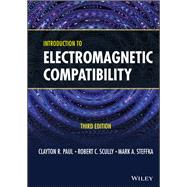INTRODUCTION TO ELECTROMAGNETIC COMPATIBILITY
The revised new edition of the classic textbook is an essential resource for anyone working with today’s advancements in both digital and analog devices, communications systems, as well as power/energy generation and distribution.
Introduction to Electromagnetic Compatibility provides thorough coverage of the techniques and methodologies used to design and analyze electronic systems that function acceptably in their electromagnetic environment. Assuming no prior familiarity with electromagnetic compatibility, this user-friendly textbook first explains fundamental EMC concepts and technologies before moving on to more advanced topics in EMC system design.
This third edition reflects the results of an extensive detailed review of the entire second edition, embracing and maintaining the content that has “stood the test of time”, such as from the theory of electromagnetic phenomena and associated mathematics, to the practical background information on U.S. and international regulatory requirements. In addition to converting Dr. Paul’s original SPICE exercises to contemporary utilization of LTSPICE, there is new chapter material on antenna modeling and simulation. This edition will continue to provide invaluable information on computer modeling for EMC, circuit board and system-level EMC design, EMC test practices, EMC measurement procedures and equipment, and more such as:
- Features fully-worked examples, topic reviews, self-assessment questions, end-of-chapter exercises, and numerous high-quality images and illustrations
- Contains useful appendices of phasor analysis methods, electromagnetic field equations and waves.
The ideal textbook for university courses on EMC, Introduction to Electromagnetic Compatibility, Third Edition is also an invaluable reference for practicing electrical engineers dealing with interference issues or those wanting to learn more about electromagnetic compatibility to become better product designers.









